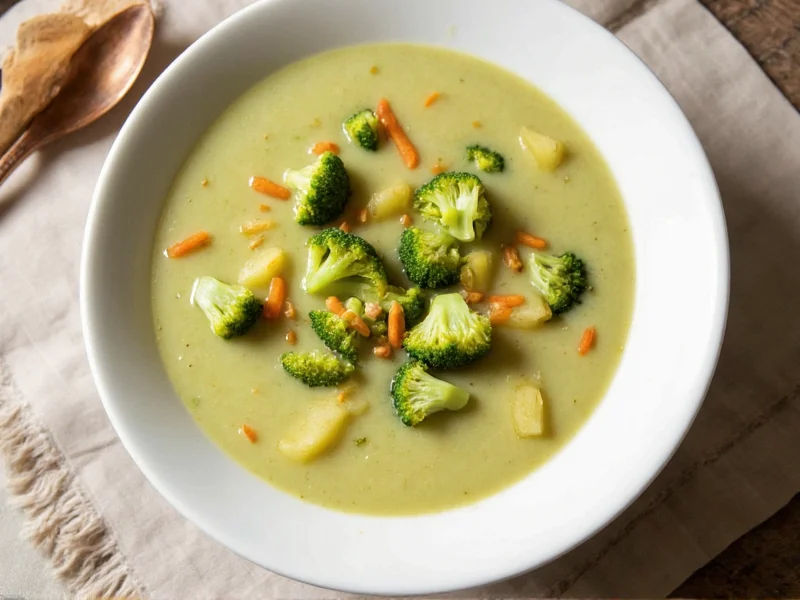Potato broccoli soup is a creamy, nutrient-rich comfort food made by blending cooked potatoes and broccoli with aromatic vegetables, broth, and seasonings. This versatile soup provides an excellent source of vitamins C and K, fiber, and potassium while remaining naturally low in calories when prepared without heavy cream or excessive cheese.
Creating the perfect potato broccoli soup requires understanding the balance between creamy texture and fresh vegetable flavor. This guide delivers a chef-tested recipe that avoids common pitfalls like grainy texture or overpowering broccoli bitterness, ensuring restaurant-quality results in your home kitchen.
The Essential Components of Great Potato Broccoli Soup
What sets exceptional potato broccoli soup apart from mediocre versions? The magic happens through three critical elements: ingredient quality, cooking technique, and seasoning balance. Fresh broccoli florets and waxy potatoes like Yukon Gold create the ideal texture foundation, while proper blanching prevents that unpleasant sulfurous taste sometimes associated with overcooked broccoli.
Core Ingredients and Their Roles
Understanding why each ingredient matters helps you become a better soup maker. The following table details essential components and their culinary functions:
| Ingredient | Function | Substitution Options |
|---|---|---|
| Yukon Gold potatoes | Natural creaminess without dairy | Red potatoes (less creamy) |
| Fresh broccoli | Flavor foundation and nutrients | Broccoli stems add fiber (use 50/50) |
| Yellow onion | Sweetness and depth | Shallots for milder flavor |
| Garlic | Aromatic complexity | 1/4 tsp garlic powder in emergency |
| Vegetable broth | Flavor carrier | Chicken broth for non-vegetarian version |
Step-by-Step Creamy Potato Broccoli Soup Recipe
This easy potato broccoli soup for beginners yields four generous servings with preparation time under 15 minutes and cooking time of 30 minutes. For the best potato broccoli soup with cheese option, see variation section.
Ingredients
- 1.5 lbs Yukon Gold potatoes, peeled and diced (about 3 medium)
- 3 cups fresh broccoli florets (stems peeled and sliced)
- 1 medium yellow onion, finely chopped
- 3 garlic cloves, minced
- 4 cups low-sodium vegetable broth
- 1 cup unsweetened almond milk (or whole milk)
- 2 tbsp olive oil
- 1 tsp dried thyme
- 1/2 tsp smoked paprika
- Salt and freshly ground black pepper to taste
Preparation Method
- Heat olive oil in a 4-quart pot over medium heat. Add onions and sauté until translucent (5 minutes).
- Add garlic and cook for 1 minute until fragrant, being careful not to burn.
- Add potatoes and 2 cups broccoli florets. Stir to coat with oil and cook for 2 minutes.
- Pour in vegetable broth, thyme, and smoked paprika. Bring to a gentle boil.
- Reduce heat to low, cover, and simmer for 15-18 minutes until potatoes are fork-tender.
- Add remaining 1 cup broccoli florets and cook uncovered for 3-4 minutes.
- Remove from heat and carefully blend with immersion blender until smooth (or in batches with regular blender).
- Stir in almond milk, then season with salt and pepper to taste.
- For creamy potato broccoli soup recipe texture, let soup rest 5 minutes before serving to allow flavors to meld.
Professional Cooking Techniques for Superior Results
Avoid the most common mistake in how to make potato broccoli soup from scratch—overcooking the broccoli. Adding half the broccoli at the end preserves both color and fresh flavor. For optimal texture, never boil the soup vigorously after blending, as this can cause separation.
When using an immersion blender, tilt your pot to create a vortex that pulls ingredients toward the blades. This prevents air bubbles and ensures perfectly smooth healthy potato broccoli soup without graininess.
Variations for Dietary Needs
Adapt this base recipe for various dietary requirements while maintaining excellent flavor:
Vegan Potato Broccoli Soup Alternative
Substitute almond milk for dairy and use nutritional yeast (2 tbsp) instead of cheese for umami depth. For richer texture, add 1/4 avocado during blending.
Gluten-Free Potato Broccoli Soup
This recipe is naturally gluten-free when using certified GF broth. Always check broth labels as some contain hidden wheat derivatives.
Lower-Carb Version
Replace half the potatoes with cauliflower for reduced carbohydrates while maintaining creamy texture.
Serving and Storage Recommendations
For the most appealing presentation of your homemade potato broccoli soup vs canned versions, garnish with:
- Fresh chives or parsley
- Cracked black pepper
- Microgreens
- A drizzle of olive oil
Potato broccoli soup storage tips: Cool completely before transferring to airtight containers. Refrigerate for up to 4 days or freeze for up to 3 months. When reheating, add a splash of broth or milk to restore ideal consistency, as the soup thickens when chilled.
Nutritional Benefits Breakdown
One 1.5-cup serving of this potato broccoli soup nutritional benefits profile includes:
- Calories: 220
- Protein: 7g
- Fiber: 6g (24% of daily value)
- Vitamin C: 110% of daily value
- Vitamin K: 180% of daily value
- Potassium: 25% of daily value
The combination of potatoes and broccoli creates a synergistic nutritional profile where the vitamin C in broccoli enhances iron absorption from the potatoes. This makes the soup particularly valuable for vegetarians and those seeking plant-based nutrition.











 浙公网安备
33010002000092号
浙公网安备
33010002000092号 浙B2-20120091-4
浙B2-20120091-4